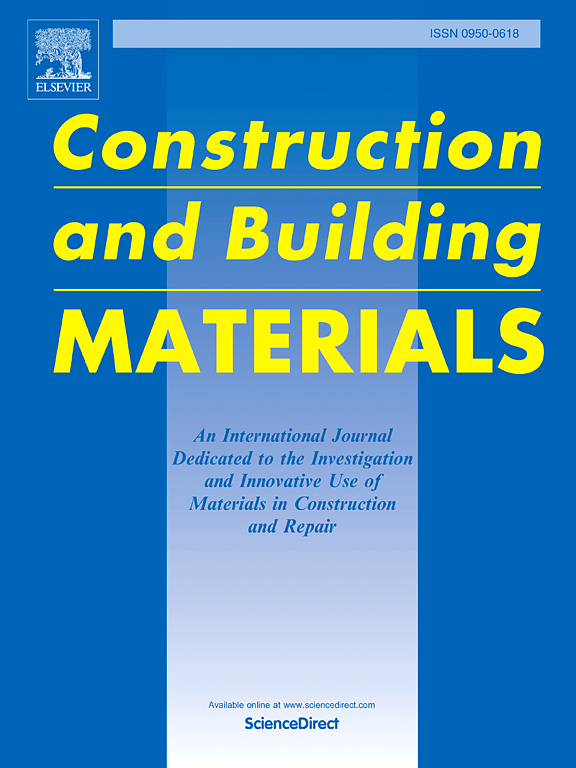回收城市生活垃圾焚烧飞灰作为功能性发泡剂制备渣基地聚合物
IF 8
1区 工程技术
Q1 CONSTRUCTION & BUILDING TECHNOLOGY
引用次数: 0
摘要
城市固体废物焚烧飞灰(MSWIFA)是一种含有重金属、氯化物和金属铝的危险副产品,对建筑材料的再利用提出了重大挑战。本研究利用MSWIFA中的金属Al与碱性活化剂反应制备自膨胀泡沫地聚合物。氢气的原位生成诱导了孔隙的形成,而溶解的前体同时聚合成C - (A) -s - h和N-A-S-H凝胶,增加了膏体的粘度,这对泡沫稳定起着关键作用。低粘度膏体允许气体逸出或孔隙聚结,而高粘度膏体则有利于气泡合并和破裂,导致泡沫不稳定。通过改变MSWIFA替代水平、NaOH浓度和碱活化剂比(NaOH:Na2SiO3),系统地研究了泡沫、聚合和孔形态之间的相互作用。关键性能,如膨胀,孔隙率,抗压强度和导热性进行了评估。微观结构分析证实了弗里德尔盐、方解石、岩盐和铝硅酸盐凝胶的形成。所有混合物均达到超过80% %的重金属固定化,符合USEPA浸出限制。这些发现证明了在低碳地聚合物体系中使用MSWIFA作为前驱体和发泡剂的可行性,并为控制孔隙形成和结构发育的耦合机制提供了新的见解。本文章由计算机程序翻译,如有差异,请以英文原文为准。
Recycling municipal solid waste incineration fly ash as a functional foaming agent in slag-based geopolymer
Municipal solid waste incineration fly ash (MSWIFA), a hazardous byproduct containing heavy metals, chlorides, and metallic aluminum, presents significant challenges for reuse in construction materials. This study utilizes the reaction between metallic Al in MSWIFA and alkaline activators to develop self-expanding foamed geopolymers. The in-situ generation of hydrogen gas induces pore formation, while simultaneous polymerization of dissolved precursors into C–(A)–S–H and N–A–S–H gels increases paste viscosity, which plays a key role in foam stabilization. Low-viscosity pastes allow gas to escape or pores to coalesce, while high viscosity facilitates bubble merging and collapse, leading to foam instability. By varying the MSWIFA replacement level, NaOH concentration, and alkali activator ratio (NaOH:Na2SiO3), the interaction between foaming, polymerization, and pore morphology was systematically investigated. Key properties such as expansion, porosity, compressive strength, and thermal conductivity were evaluated. Microstructural analyses confirmed the formation of Friedel’s salt, calcite, halite, and aluminosilicate gels. All mixtures achieved over 80 % heavy metal immobilization, complying with USEPA leaching limits. These findings demonstrate the feasibility of using MSWIFA as both a precursor and foaming agent in low-carbon geopolymer systems and offer insights into the coupled mechanisms that govern pore formation and structural development.
求助全文
通过发布文献求助,成功后即可免费获取论文全文。
去求助
来源期刊

Construction and Building Materials
工程技术-材料科学:综合
CiteScore
13.80
自引率
21.60%
发文量
3632
审稿时长
82 days
期刊介绍:
Construction and Building Materials offers an international platform for sharing innovative and original research and development in the realm of construction and building materials, along with their practical applications in new projects and repair practices. The journal publishes a diverse array of pioneering research and application papers, detailing laboratory investigations and, to a limited extent, numerical analyses or reports on full-scale projects. Multi-part papers are discouraged.
Additionally, Construction and Building Materials features comprehensive case studies and insightful review articles that contribute to new insights in the field. Our focus is on papers related to construction materials, excluding those on structural engineering, geotechnics, and unbound highway layers. Covered materials and technologies encompass cement, concrete reinforcement, bricks and mortars, additives, corrosion technology, ceramics, timber, steel, polymers, glass fibers, recycled materials, bamboo, rammed earth, non-conventional building materials, bituminous materials, and applications in railway materials.
 求助内容:
求助内容: 应助结果提醒方式:
应助结果提醒方式:


